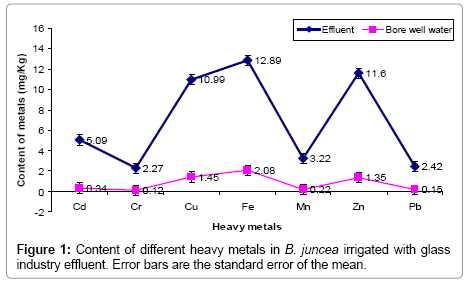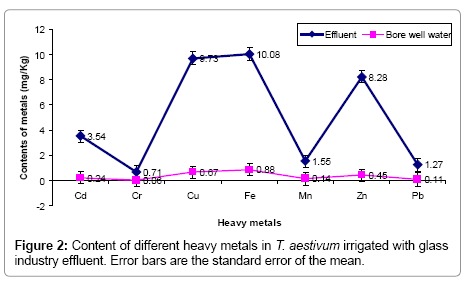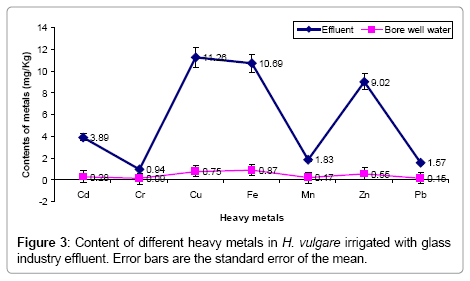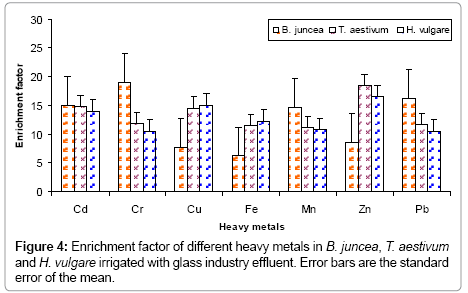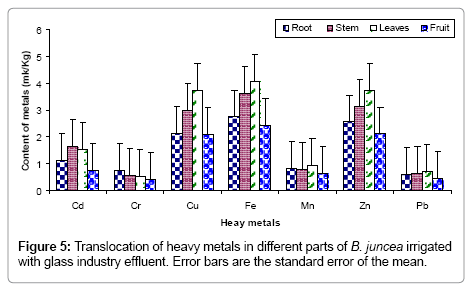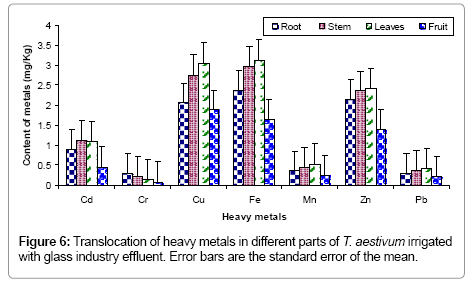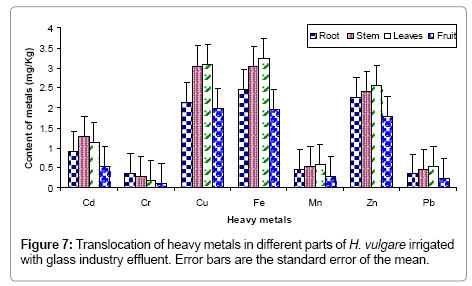Heavy Metals Accumulation in Soil and Agricultural Crops Grown in the Province of Asahi India Glass Ltd., Haridwar (Uttarakhand), India
Received: 30-Nov-2015 / Accepted Date: 11-Dec-2015 / Published Date: 17-Dec-2015 DOI: 10.4172/2329-8863.1000203
Abstract
This investigation was aimed to assess the heavy metals accumulation in soil and agricultural crops viz., Indian mustard (Brassica juncea L.), wheat (Triticum aestivum L.) and barley (Hordeum vulgare L.) irrigated with glass industry effluent. The glass industry effluent was considerably loaded with various plant nutrients and heavy metals. The effluent irrigation significantly (P<0.05/P<0.01) increased Cd, Cr, Cu, Fe, Mn, Pb, Zn, total bacteria, total fungi, actinomycetes and yeast of the soil used for the cultivation of B. juncea, T. aestivum and H. vulgare. The enrichment of different heavy metals were recorded in the order of Cr>Pb>Cd>Mn>Zn>Cu>Fe for B. juncea, Zn>Cd>Cu>Cr>Pb>Fe>Mn for T. aestivum and Zn>Cu>Cd>Fe>Mn>Pb>Cr for H. vulgare irrigated with glass industry effluent. The translocation of different metals in different parts i.e. root, stem, leaves and fruits were observed in the order of leaves > stem > root > fruit for Cu, Fe, Mn, Pb and Zn; stem > leaves > root > fruit for Cd, root > stem > leaves > fruit for Cr in B. juncea, T. aestivum and H. vulgare irrigated with glass industry effluent. Therefore, glass industry effluent irrigation added heavy metals in the soil and B. juncea, T. aestivum and H. vulgare.
Keywords: Accumulation; Agricultural crops; Enrichment factor; Glass industry effluent; Heavy metals; Soil
Introduction
Contamination of soil and agricultural crops from industrial waste is a result of various types of industrial processes and disposal practices [1-4]. Industries that use large amounts of water for processing have the potential to pollute waterways through the discharge of their waste into streams and rivers, or by run-off and seepage of stored wastes into nearby water sources [5-7]. Other disposal practices which cause water contamination include deep well injection and improper disposal of wastes in surface impoundments. Discharge of industrial effluent without adequate treatment causes severe degradation in the pedosphere, hydrosphere, and atmosphere [8-10]. Effluents from industries contain appreciable amounts of nitrogen (N), phosphorous (P), sodium (Na), potassium (K), calcium (Ca), and magnesium (Mg) along with zinc (Zn), copper (Cu), iron (Fe), manganese (Mn), lead (Pb), nickel (Ni), and cadmium (Cd), and their disposal cause contamination of soil and water environment [2,11-13].
With the rapid enhancement in industrial establishment, there has been substantial increase in the liquid waste which is traditionally discharged either into open land or nearby water courses [14,15]. Industrial effluent is mostly used for the fertigation of agricultural crops, mainly in urban and periurban regions, due to its easy availability, disposal problems and scarcity of irrigation water. In addition, the industrial effluents are the main sources of soil and water contamination [16-18]. Although, effluent irrigation can alleviate water scarcity situations and allows farmers to reduce the purchase of chemical fertilizer and of organic matter that serves as soil conditioner and humus replenishment [10]. However, unregulated irrigation with untreated wastewater poses serious public health risks, as effluent is a major source of heavy metals that cause accumulation in plant parts [13,19,20]. Heavy metals accumulation in agricultural soils is of increasing worldwide concern and particularly in India with the rapid development of industrialization and urbanization [21-23]. The crop plants take up heavy metals and accumulate them in their edible and inedible parts in quantities high enough to cause clinical problems both to animals and human beings consuming these metal-rich plants [4,24,25]. Moreover, a number of serious health problems can develop as a result of excessive uptake of dietary heavy metals [26,27]. Additionally, the heavy metals such as cadmium (Cd), chromium (Cr), copper (Cu), iron (Fe), nickel (Ni) and zinc (Zn) reaches to the soil through effluent irrigation, and accumulates in plant and vegetable parts, and cause adverse health effects [15,23,28-30]. Keeping in view the present investigation was carried out to the heavy metals accumulation in soil and agricultural crops grown in the Province of Asahi India Glass Ltd., Haridwar (Uttarakhand), India.
Materials and Methods
Study area
Asahi India Glass Ltd. Jhabrera, Roorkee, Haridwar (29°47’50”N 77°48’23”E) was selected for the present study. The glass industry is located about 45 km away from Haridwar at Haridwar Saharanpur via Jhabrera Highway. Asahi India Glass is the largest integrated glass company in India. They manufacture a wide range of international quality automotive safety glass, float glass, architectural processed glass and glass products. The glass industry is using a large quantity of fresh water and discharged huge amount of effluent. The effluent is being used by the farmers in the cultivation of agricultural crops.
Collection of effluent samples and their analysis
The effluent samples were collected from the effluent disposal channel used for the irrigation of agricultural crops in the vicinity of glass industry. Bore well water is considered as control. The samples of glass industry effluent and bore well water were collected in thoroughly cleaned plastic containers of 5 liters capacity separately. The samples were brought to the laboratory and were analyzed for various physicochemical parameters and microbiological viz., total dissolved solids (TDS), electrical conductivity (EC), pH, biochemical oxygen demand (BOD), chemical oxygen demand (COD), total Kjeldahl nitrogen (TKN), phosphate (PO4 3-), sodium (Na+), potassium (K+), calcium (Ca2+), magnesium (Mg2+), cadmium (Cd), chromium (Cr), copper (Cu), iron (Fe), lead (Pb), manganese (Mn), zinc (Zn), total bacteria, total fungi, total coliform and yeast following standard methods [31].
Collection of soil samples and their analysis
The soil samples from the surface (0-20 cm) were collected from the effluent irrigated agricultural fields in the vicinity of Asahi India Glass Ltd. The bore well water irrigated soil was taken as control. The samples were brought to the laboratory and dried in clean plastic trays for 7 days at room temperature and then sieved through a 2 mm sieve. The samples were analyzed for various physico-chemical and microbiological parameters viz., viz., EC, organic carbon (OC), TKN, PO4 3-, Na+, K+, Ca2+, Mg2+, Cd, Cr, Cu, Fe, Mn, Pb, Zn, total bacteria, total fungi, actinomycetes and yeast following standard methods [32].
Collection of agricultural crops samples and their analysis
Glass industry effluent irrigated crops viz., Indian mustard (Brassica juncea), wheat (Triticum aestivum) and barley (Hordeum vulgare) grown in the vicinity of Glass Industry were selected for the present study. Bore well water irrigated B. juncea, T. aestivum and H. vulgare were taken as control. The samples of B. juncea, T. aestivum and H. vulgare from effluent and bore well water irrigated agricultural filed were collected in the polythene bags separately. The samples were brought to the laboratory and washed thrice under tap water and followed by distilled water. The crop samples were cut with a sharp knife then air dried and ground and sieved. For the extraction of metals, 10 ml sample of wastewater, 1.0 g sample of air dried soil/crops was taken in digestion tube. In each sample 3 ml concentrate HNO3 was added and digested on electrically heated block for 1 hour at 145°C. Then 4 ml of HClO4 was added and heated to 240°C for an additional hour. The aliquot was cooled, filtered through Whatman # 42 filter paper and the volume was made 50 ml with double distilled water and used for analysis. The metals were analyzed by using atomic absorption spectrophotometer (PerkinElmer Analyst 800 AAS) following standard methods. The enrichment factor for metals accumulated in wastewater irrigated soil and vegetables were calculated by following formula.

Statistical analysis
The values reported here are means of six values. Data were tested at different significant levels using student t-test to measure the variations between the soil parameters before and after irrigation of these crops with wastewater. One way analysis of variance (ANOVA) was used for data analysis to measure the variations of metals in different parts of these crops before and after glass industry effluent irrigation was calculated with the help of MS Excel, 2013.
Results And Discussion
Occurrence of heavy metals in industrial effluents
The physico-chemical and microbiological properties of glass industry effluent are presented in Table 1. The results revealed that the glass industry effluent was considerably rich in various plant nutrients like TKN (384.75 mg L-1), PO4 3-(145.67 mg L-1), Na+(185.65 mg L-1), K+(220.90 mg L-1), Ca2+(450.87 mg L-1), Mg2+(230.00 mg L-1) and heavy metals Cd (2.75 mg L-1), Cr (1.26 mg L-1), Cu (6.88 mg L-1), Fe (12.89 mg L-1), Mn (1.54 mg L-1), Pb (2.36 mg L-1) and Zn (8.80 mg L-1). The values of TDS (3640 mg L-1), BOD (1450.60 mg L-1), COD (1890.80 mg L-1), TKN, Ca2+, Cd, Cu, Fe and Zn were observed beyond the prescribed limit of BIS irrigation standards [33]. Moreover, higher values of microbiological parameter total bacteria (8.57 × 108 CFU ml- 1), total fungi (5.23 × 105 CFU mL-1), total coliform (4.26 × 103 MPN 100 mL-1) and yeast (3.76 × 103 CFU mL-1) were also observed in the glass industry effluent. The higher value of EC (3.24 dS cm-1) is the indicator of more ionic species in the glass industry effluent. The higher values of BOD, COD, TKN and PO4 3- in the glass industry effluent are the indicator of higher organic load of the effluent and it is likely due to the mixing of sewage in the glass industry effluent generated from the staff quarters and offices located in the premises of the glass industry. The higher contents of heavy metals the glass industry effluent is might be associated with silicate minerals using as raw materials in the glass manufacturing and various colouring agents to make the coloured glass panels. Kumar and Chopra [13] also reported higher values of BOD (1256.50 mg L-1), COD (2832.50 mg L-1), Cd (2.98 mg L-1), Cr (1.68 mg L-1), Cu (3.56 mg L-1), Fe (15.25 mg L-1), Pb (0.94 mg L-1), Zn (6.42 mg L-1), total bacteria (9.89 × 107 SPC mL-1) and coliform bacteria (5.69 × 106 MPN 100 mL-1) in the paper mill effluent. Therefore, the glass industry effluent showed higher organic as well as inorganic pollution load.
| Parameter | Borewell water (control) | Composite effluent | BIS disposal standards |
|---|---|---|---|
| TDS (mg L-1) | 210.50 ± 2.58 | 3640 ± 3.64 | 1900 |
| EC (dS cm-1) | 0.24 ± 0.04 | 3.24 ± 0.14 | - |
| pH | 7.45 ± 0.05 | 7.85 ± 0.08 | 5.5-9.0 |
| BOD5 (mg L-1) | 4.59 ± 0.08 | 1450.60 ± 4.50 | 100 |
| COD (mg L-1) | 8.97 ± 0.25 | 1890.80 ± 5.20 | 250 |
| TKN (mg L-1) | 28.90 ± 1.08 | 384.75 ± 2.96 | 100 |
| PO4 3- (mg L-1) | 0.04 ± 0.01 | 145.67 ± 1.05 | - |
| Na+ (mg L-1) | 10.66 ± 0.21 | 185.65 ± 2.30 | - |
| K+ (mg L-1) | 6.80 ± 0.15 | 220.90 ± 2.40 | - |
| Ca2+ (mg L-1) | 26.90 ± 0.16 | 450.87 ± 3.74 | 200 |
| Mg2+ (mg L-1) | 14.66 ± 0.23 | 230.00 ± 2.66 | - |
| Cd (mg L-1) | 0.36 ± 0.02 | 2.75 ± 0.05 | 2.00 |
| Cr (mg L-1) | 0.08 ± 0.01 | 1.26 ± 0.02 | 2.00 |
| Cu (mg L-1) | 1.26 ± 0.02 | 6.88 ± 0.08 | 3.00 |
| Fe (mg L-1) | 1.45 ± 0.03 | 12.89 ± 0.25 | 1.0 |
| Mn (mg L-1) | 0.36 ± 0.01 | 1.54 ± 0.03 | - |
| Zn (mg L-1) | 2.17 ± 0.54 | 8.80 ± 0.06 | 15 |
| Pb (mg L-1) | 0.24 ± 0.02 | 2.36 ± 0.04 | - |
| Total bacteria (CFU ml -1) | 5.64 × 103 ± 4.00 | 8.57 × 108 ± 14.00 | 10000 |
| Total fungi (CFU ml -1) | 3.75 × 102 ± 5.00 | 5.23 × 105 ± 12.00 | - |
| Total coliform (MPN 100 ml -1) | 2.23 × 102 ± 3.00 | 4.26 × 103 ± 6.00 | 5000 |
| Yeast (CFU ml -1) | 1.43 × 102 ± 2.00 | 3.76 × 103 ± 7.00 | - |
Mean ± SE of six values; BIS- Bureau of Indian Standards
Table 1: Physico-chemical and microbiological characteristics of glass industry effluent.
Occurrence of heavy metals in agricultural soil
Table 2 showed the soil characteristics used in the cultivation of B. juncea, T. aestivum and H. vulgare irrigated with glass industry effluent and bore well water. On perusal of data it is clearly indicated that glass industry effluent significantly (P<0.05/P<0.01/P<0.001) increased EC, OC, TKN, PO4 3-, Na+, K+, Ca2+, Mg2+, Cd, Cr, Cu, Fe, Mn, Pb, Zn, total bacteria, total fungi, actinomycetes and yeast of the soil used for the cultivation of B. juncea, T. aestivum and H. vulgare compared to bore well water. During the investigation the soil was loamy in texture and no significant change was observed in the soil texture during the study. The pH value is an important parameter, as many nutrients are available only at a particular range of pH for plant uptake. A pH value of 6.0–8.2 provides predominating bacterial activity and is favorable for maximum yield of crops. The pH of the soil was ranged (7.56-7.68) after irrigation with glass industry effluent. The higher content of OC, TKN and PO4 3- were recorded in the soils used for the cultivation of B. juncea, T. aestivum and H. vulgare which is likely due the more organic nature of glass industry effluent. The higher contents of OC (3.45-4.12 mg Kg-1), TKN (268.58-298.50 mg Kg-1) and PO4 3- (114.67-173.77 mg Kg-1) were recorded in the soil used for the cultivation of B. juncea, T. aestivum and H. vulgare. The higher values of OC, TKN and PO4 3- are the indicator of soil fertility and support the higher population of microbial communities in the soil as earlier reported by Kumar and Chopra [7]. The contents of different heavy metals in the soil used for the cultivation of B. juncea, T. aestivum and H. vulgare were ranged Cd (0.66-0.84 mg Kg-1), Cr (0.24-0.28 mg Kg-1), Cu (4.37-5.84 mg Kg-1), Fe (6.84-7.58 mg Kg-1), Mn (1.38-1.56 mg Kg-1), Pb (0.23-0.29 mg Kg- 1), Zn (3.75-4.15 mg Kg-1) after irrigation with glass industry effluent (Table 2). The most contents of heavy metals were recorded in the soil used for the cultivation of T. aestivum while the least were found in the soil used for the cultivation of B. juncea. Thus it clearly indicated that B. juncea was more efficient for the uptake of heavy metals compared to H. vulgare and T. aestivum. The findings are in line of Chopra et al. [18] who reported higher contents of Cd (4.34 mg Kg-1), Cr (1.65 mg Kg-1), Cu (7.86 mg Kg-1), Fe (10.55 mg Kg-1), Mn (1.87 mg Kg-1) and Zn (8.85 mg Kg-1) in the paper mill effluent irrigated soil. Significant (P<0.05/P<0.01) microbial population in the form of total bacteria (4.85 × 107-7.75 × 109 CFU g-1), total fungi (3.25 × 105-6.35 × 106 CFU g-1), actinomycetes (5.88 × 103 -9.86 × 104 CFU g-1) and yeasts (4.00 × 104 -5.65 × 105 CFU g-1) were observed in the soil irrigated with glass industry effluent compared to control soil (bore well water irrigated soil) (Table 2). The findings are in accordance with Beligh et al. [16] who reported significantly higher microbial community in the soil irrigated with olive mill wastewater. The organic carbon and pH are principal components that control the accessibility of heavy metals in the soil. Increasing the soil organic carbon can enhance the soil electrical conductivity and effective cation exchange capacity, which is a reason that may affect both soluble and exchangeable metals [2,34]. However, in the present study, the effects of glass on the soil pH seemed to be one of the promising factors, which affects the availability, and accumulation of Cd, Cr, Cu, Fe, Mn, Pb and Zn. Despite the fact that, the contents of Cd, Cr, Cu and Zn were found to be below the maximum levels permitted for Cd (6.0 mg kg-1), Cr (10.0 mg kg-1), Cu (270 mg kg-1) and Zn (600 mg kg-1) for soil in India [33]. However, there was gradual buildup of these metals in the glass industry effluent irrigated soil and this is likely due to the addition of more organic carbon in the soil which provides more binding sites for the attachment of these metals. Therefore, glass industry effluent irrigation significantly altered the contents of heavy metals in the soil used for the cultivation of B. juncea, T. aestivum and H. vulgare.
| Parameter | Borewell water irrigated soil (control) | Glass industry effluent irrigated soil | ||
|---|---|---|---|---|
| B. juncea | T. aestivum | H. vulgare | ||
| EC (dS cm-1) | 2.18 ± 0.05 | 3.04* ± 0.06 | 3.40* ± 0.08 | 3.13* ± 0.06 |
| pH | 7.49 ± 04 | 7.56 ± 0.03 | 7.62 ± 0.04 | 7.68 ± 0.05 |
| OC | 0.56 ± 02 | 3.45** ± 0.10 | 4.12** ± 0.15 | 3.87** ± 0.13 |
| TKN (mg Kg-1) | 33.41 ± 3.94 | 268.58*** ± 4.27 | 298.50*** ± 1.84 | 285.18*** ± 2.84 |
| PO43- (mg Kg-1) | 55.54 ± 5.72 | 114.67*** ± 1.86 | 173.77*** ± 1.24 | 121.56*** ± 1.95 |
| Na+ (mg Kg-1) | 21.32 ± 2.50 | 28.96* ± 2.17 | 33.28* ± 1.64 | 49.84** ± 1.47 |
| K+ (mg Kg-1) | 169.01 ± 3.06 | 188.96* ± 1.95 | 219.97* ± 2.36 | 210.06* ± 1.06 |
| Ca2+ (mg Kg-1) | 17.73 ± 1.94 | 118.75** ± 2.36 | 129.92*** ± 2.05 | 122.03*** ± 1.16 |
| Mg2+ (mg Kg-1) | 1.72 ± 10 | 12.67*** ± 1.02 | 16.75*** ± 1.02 | 18.94*** ± 1.01 |
| Cd (mg Kg-1) | 0.24 ± 0.07 | 0.66** ± 0.03 | 0.84** ± 0.03 | 0.75** ± 0.02 |
| Cr (mg Kg-1) | 0.17 ± 0.06 | 0.24* ± 16 | 0.28* ± 16 | 0.26* ± 0.09 |
| Cu (mg Kg-1) | 2.37 ± 0.35 | 4.37* ± 0.91 | 5.84* ± 0.91 | 5.26* ± 1.07 |
| Fe (mg Kg-1) | 3.13 ± 0.44 | 6.96* ± 0.75 | 7.58** ± 0.75 | 6.84* ± 0.0.09 |
| Mn (mg Kg-1) | 0.11 ± 0.06 | 1.38** ± 16 | 1.56** ± 16 | 1.43** ± 0.03 |
| Zn (mg Kg-1) | 1.96 ± 17 | 3.75* ± 0.35 | 4.15** ± 0.35 | 4.02** ± 0.08 |
| Pb (mg Kg-1) | 0.07 ± 0.06 | 0.23** ± 0.02 | 0.29** ± 0.02 | 0.25** ± 0.01 |
| Total bacteria (CFU g -1) | 2.56×106 ± 8.00 | 7.75×109*** ± 6.00 | 5.69×108** ± 9.00 | 4.85×107** ± 7.00 |
| Total fungi (CFU g -1) | 1.45×105 ± 4.00 | 6.35×106* ± 4.00 | 3.25×105* ± 5.00 | 4.05×105* ± 3.00 |
| Actinomycetes (CFU g -1) | 1.67×103 ± 5.00 | 9.86×104* ± 8.00 | 6.93×103* ± 6.00 | 5.88×103* ± 7.00 |
| Yeast (CFU g -1) | 3.45×104 ± 6.00 | 5.65×105* ± 7.00 | 4.12×104* ± 9.00 | 4.00×104* ± 5.00 |
Mean ± SE of six values; Significant F -***P-0.1%, **P-1% level,*P-5% level of ANOVA to the control.
Table 2: Effects of glass industry effluent irrigation on soil characteristics used for the cultivation of B. juncea, T. aestivum and H. vulgare.
Occurrence of heavy metals in agricultural crops
During the present investigation, the contents of heavy metals Cd (3.54-5.09 mg Kg-1), Cr (0.71-2.27 mg Kg-1), Cu (9.73-10.99 mg Kg-1), Fe (10.08-12.89 mg Kg-1), Mn (1.55-3.22 mg Kg-1), Pb (1.27-2.42 mg Kg-1) and Zn (8.28-11.60 mg Kg-1) were ranged in B. juncea, T. aestivum and H. vulgare after irrigation with glass industry effluent (Figures 1-3). The maximum contents of Cd, Cr, Cu, Fe, Mn, Pb and Zn were recorded in B. juncea while the least contents of these metals were observed in T. aestivum after irrigation with glass industry effluent. The enrichment of different heavy metals were recorded in the order of Cr>Pb>Cd>Mn>Zn>Cu>Fe for B. juncea, Zn>Cd>Cu>Cr>Pb>Fe>Mn for T. aestivum and Zn>Cu>Cd>Fe>Mn>Pb>Cr for H. vulgare after irrigation with glass industry effluent (Figure 4). The translocation of metals in different parts i.e. root, stem, leaves and fruits of B. juncea was ranged Cd (0.76-1.65 mg Kg-1), Cr (0.42-0.76 mg Kg-1), Cu (2.09-3.74 mg Kg-1), Fe (2.42-4.08 mg Kg-1), Mn (0.64-0.0.96 mg Kg-1), Pb (0.44- 0.72 mg Kg-1) and Zn (2.12-3.75 mg Kg-1); in T. aestivum Cd (0.45-1.12 mg Kg-1), Cr (0.08-0.28 mg Kg-1), Cu (1.88-3.05 mg Kg-1), Fe (1.65-3.12 mg Kg-1), Mn (0.24-0.52 mg Kg-1), Pb (0.21-0.42 mg Kg-1) and Zn (1.38- 2.41 mg Kg-1) and in H. vulgare Cd (0.54-1.29 mg Kg-1), Cr (0.11-0.36 mg Kg-1), Cu (1.99-3.08 mg Kg-1), Fe (1.96-3.24 mg Kg-1), Mn (0.28-0.58 mg Kg-1), Pb (0.25-0.52 mg Kg-1) and Zn (1.78-2.56 mg Kg-1) irrigated with glass industry effluent (Figures 5-7). The translocation of different metals in different parts i.e. root, stem, leaves and fruits were observed in the order of leaves > stem > root > fruit for Cu, Fe, Mn, Pb and Zn; stem > leaves > root > fruit for Cd, root > stem > leaves > fruit for Cr in B. juncea, T. aestivum and H. vulgare after irrigation with glass industry effluent (Figures 5-7). The accessibility and bioaccumulation of metals are governed by numerous environmental factors viz. pH, solubility, and chemical speciation of the metal, presence of humic substances, presence of other metals, salinity, soil mineralogy, texture, and amorphous Fe and Al contents [2,35]. However, the observed differences in the metal accumulation in the different parts like root, stem, leaves and fruits of the plant suggest different cellular mechanisms of bioaccumulation of heavy metals, which may control their translocation and partitioning in the plant. Cu, Fe, Mn and Zn are associated with the photosynthesis [2,28,36]. The content of Cu, Fe, Mn and Zn was higher in the leaves of B. juncea, T. aestivum and H. vulgare and it is likely due to the higher content of these metals in the glass industry effluent irrigated soil. Cu, Fe and Zn are indispensable for the survival and proliferation of all plants. There is a high demand for Cu, Fe and Zn in the photosynthetic apparatus as a result plants accumulates and translocates Cu, Fe and Zn in their photosynthetic parts [2,36]. Moreover the translocation of Cd, Cr, Cu, Fe, Mn, Pb and Zn are related to the organic matter in the soil, which enhanced their uptake by cultivated plants [2,37].
The contents of Cr were higher in the roots of B. juncea, T. aestivum and H. vulgare than in the aerial parts (i.e., stem, leaves and fruits), indicating that the roots act as barrier for translocation and protect the edible parts from toxic contamination [2]. Deprived translocation of Cr to the shoots and leaves could be due to the sequesterization of most of the Cr in the vacuoles of the root cells to render it non-toxic, which may be a natural protective response of this plant [23]. It must be noted that Cr is a toxic and non-essential element to plants and hence the plants may not possess any specific mechanism to transport the Cr [18,34]. The content of Cd, Cr, Cu, Fe, Mn, Pb and Zn were less in the fruits of B. juncea, T. aestivum and H. vulgare and it is likely due to increases in cation-exchange capacity of the soil, which will decrease the uptake of Cd, Cr, Cu, Fe, Mn, Pb and Zn into B. juncea, T. aestivum and H. vulgare plants. Therefore, among B. juncea, T. aestivum and H. vulgare, B. juncea was found most efficient compared to T. aestivum and H. vulgare to translocate and tolerate the metals contents after irrigation with glass industry effluent. Although the contents of Cr, Cu, Mn and Zn except Cd in B. juncea, T. aestivum and H. vulgare was noted below the permissible limit of FAO/WHO standards for Cd (0.20 mg Kg-1), Cr (2.30 mg Kg-1), Cu (40.00 mg Kg-1) and Zn (60.00 mg Kg-1) [27]. But long-term application of glass industry effluent in the cultivation of B. juncea, T. aestivum and H. vulgare would carry a risk of progressive accumulation of these heavy metals to toxic levels. The findings are in agreement with Chandra et al. [30] who reported the higher content of heavy metals in wheat (Triticum aestivum L.) and Indian mustard (Brassica campestris L.) irrigated with distillery and tannery effluents.
Conclusion
This study concluded that glass industry effluent irrigation significantly (P<0.05/P0.01) changed the soil properties specially increased the contents of different heavy metals viz., Cd, Cr, Cu, Fe, Mn, Pb and Zn in the soil and further in B. juncea, T. aestivum and H. vulgare. The accumulation and translocation of heavy metals were found to be plant part specific and varied from species to species and it is likely due to the uptake efficiency and tolerance capability of different species. The most accumulation of Cd, Cr, Cu, Fe, Mn, Pb and Zn were recorded in B. juncea while the least was in T. aestivum. The contents of Cr, Cu, Mn and Zn except Cd in B. juncea, T. aestivum and H. vulgare was noted below the permissible limit of FAO/WHO standards but continuous use of glass industry effluent of these crops would increase these metals in these crop plants. Therefore, care should be taken before the use of glass industry effluent in the cultivation of agricultural crops like B. juncea, T. aestivum and H. vulgare crops. Further studies are required on the use of glass industry effluent in the cultivation of different agricultural crops and their health effects after consumption.
References
- Qishlaqi A, Moore F, Forghani G (2008) Impact of untreated wastewater irrigation on soils and crops in Shiraz suburban area, SW Iran. Environ Monit Assess 141: 257-273.
- Kumar V, Chopra AK (2014) Accumulation and translocation of metals in soil and different parts of French bean (Phaseolus vulgaris L.) amended with sewage sludge. Bull Environ ContamToxicol 92: 103-108.
- Kumar V, Chopra AK (2013) Response of sweet sorghum after fertigation with sugar mill effluent in two seasons. Sugar Tech 15: 285-299.
- Chaturvedi M, Kumar V, Singh D, Kumar S (2013) Assessment of microbial load of some common vegetables among two different socioeconomic groups. International Food Research Journal 20: 2927-2931.
- Bharagava RN, Chandra R, Rai V (2008) Phytoextraction of trace elements and physiological changes in Indian mustard plants (Brassica nigra L) grown in post methanated distillery effluent (PMDE) irrigated soil. BioresourTechnol 99: 8316-8324.
- Chary NS, Kamala CT, Raj DS (2008) Assessing risk of heavy metals from consuming food grown on sewage irrigated soils and food chain transfer. Ecotoxicol Environ Saf 69: 513-524.
- Kumar V, Chopra AK (2012) Effect of paper mill effluent irrigation on agronomical characteristics of Vigna radiata (L.) in two different seasons. Communications in Soil Science and Plant Analysis 43: 2142-2166.
- Sharif A Salah, Suzelle F Barrington (2006) Effect of soil fertility and transpiration rate on young wheat plants (Triticum aestivum) Cd/Zn uptake and yield. Agricultural Water Management 82: 177-192.
- Clemente R, Dickinson NM, Lepp NW (2008) Mobility of metals and metalloids in a multi-element contaminated soil 20 years after cessation of the pollution source activity. Environ Pollut 155: 254-261.
- Kumar V, Chopra AK (2011) Impact on physico-chemical characteristics of soil after irrigation with distillery effluent. Archives of Applied Science Research 3: 63-77.
- Muchuweti M, Birkett JW, Chinyanga E, Zvauya R, Scrimshaw MD, et al. (2006) Heavy metal content of vegetables irrigated with mixture of wastewater and sewage sludge in Zimbabwe: Implications for human health. Agriculture Ecosystem and Environment 112: 41-48.
- Qadir M, Wichelns D, Raschid-Sally I, McCornik PG, Drechsel P, et al. (2009) The challenges of wastewater irrigation in developing countries. Agriculture Water Management 97: 561-568.
- Kumar V, Chopra AK (2013) Enrichment and translocation of heavy metals in soil and Vicia faba L. (Faba bean) after fertigation with distillery effluent. International Journal of Agricultural Policy and Research 1: 131-141.
- Wang JF, Wang GX, Wanyan H (2007) Treated wastewater irrigation effect on soil, crop and environment: wastewater recycling in the loess area of China. J Environ Sci (China) 19: 1093-1099.
- Pathak C, Chopra AK, Kumar V, Sharma S (2011) Effect of sewage-water irrigation on physico-chemical parameters with special reference to heavy metals in agricultural soil of Haridwar city. Journal of Applied and Natural Science 3: 108-113.
- Beligh M, Fethi Ben Mariem, Mohamed Baham, Salem Ben Elhadj, Mohamed Hammami (2008) Change in soil properties and the soil microbial community following land spreading of olive mill wastewater affects olive trees key physiological parameters and the abundance of arbuscularmycorrhizal fungi. Soil Biology and Biochemistry 40: 152-161.
- Tewari PK, Batra VS, Balakrishnan M (2009) Efficient water use in industries: cases from the Indian agro-based pulp and paper mills. J Environ Manage 90: 265-273.
- Chopra AK, Srivastava S, Kumar V (2011) Comparative study on agro-potentiality of Paper mill effluent and synthetic nutrient (DAP) on Vigna unguiculata L. (Walp) Cowpea. Journal of Chemical and Pharmaceutical Research 3: 151-165.
- Yadav RK, Goyal B, Sharma RK, Dubey SK, Minhas PS (2002) Post-irrigation impact of domestic sewage effluent on composition of soils, crops and ground water--a case study. Environ Int 28: 481-486.
- Sharma RK, Agrawal M, Marshall F (2006) Heavy metal contamination in vegetables grown in wastewater irrigated areas of Varanasi, India. Bull Environ ContamToxicol 77: 312-318.
- Al-Lahham O, El Assi NM, Fayyad M (2003) Impact of treated wastewater irrigation on quality attributes and contamination of tomato fruit. Agriculture Water Management 61: 51-62.
- Hati M Kuntal, AnandSwarup, Dwivedi, Misra AK, Bandyopadhyay KK (2007) Changes in soil physical properties and organic carbon status at the topsoil horizon of a vertisol of central India after 28 years of continuous cropping, fertilization and manuring. Agriculture Ecosystem and Environment 119: 127-134.
- Chopra AK, Srivastava S, Kumar V, Pathak C (2013) Agro-potentiality of distillery effluent on soil and agronomical characteristics of Abelmoschus esculentus L. (okra). Environ Monit Assess 185: 6635-6644.
- Nastri A, Ramieri NA, Abdayem R, Piccaglia R, Marzadori C, et al. (2006) Olive pulp and its effluents suitability for soil amendment. J Hazard Mater 138: 211-217.
- Paulose B, Datta SP, Rattan RK, Chhonkar PK (2007) Effect of amendments on the extractability, retention and plant uptake of metals on a sewage-irrigated soil. Environ Pollut 146: 19-24.
- Fytianos K, Katsianis G, Triantafyllou P, Zachariadis G (2001) Accumulation of heavy metals in vegetables grown in an industrial area in relation to soil. Bull Environ ContamToxicol 67: 423-430.
- FAO/WHO (2011) Joint FAO/WHO food standards programme codex committee on contaminants in foods, fifth session 64-89.
- Barman SC, Sahu RK, Bhargava SK, Chaterjee C (2000) Distribution of heavy metals in wheat, mustard, and weed grown in field irrigated with industrial effluents. Bull Environ ContamToxicol 64: 489-496.
- Munir J, Mohammad Rusan, Sami Hinnawi,LaithRousan (2007) Long term effect of wastewater irrigation of forage crops on soil and plant quality parameters. Desalination 215: 143-152.
- Chandra R, Bharagava RN, Yadav S, Mohan D (2009) Accumulation and distribution of toxic metals in wheat (Triticum aestivum L.) and Indian mustard (Brassica campestris L.) irrigated with distillery and tannery effluents. J Hazard Mater 162: 1514-1521.
- APHA (2012) Standard methods for the examination of water and wastewater. American Public Health Association, 21st ed., Washington, DC 2462.
- Chaturvedi RK, Sankar K (2006) Laboratory manual for the physicochemical analysis of soil, water and plant. Wildlife Institute of India, Dehradun 97.
- BIS (2010) Bureau of Indian Standards: Indian standards for drinking water-Specification (BIS 10500:2010).
- Kim KH, Kim SH (1999) Heavy metal pollution of agricultural soils in central regions of Korea.Water Air and Soil Pollution 111: 109-122.
- Gu C, Bai Y, Tao T, Chen G, Shan Y (2013) Effect of sewage sludge amendment on heavy metal uptake and yield of ryegrass seedling in a mudflat soil. J Environ Qual 42: 421-428.
- Porra RJ (2002) Thechequered history of the development and use of simultaneous equations for the accurate determination of chlorophylls a and b. Photosynth Res 73: 149-156.
- Zarcinas BA, Pongsakul P, McLaughlin MJ, Cozens G (2004) Heavy metals in soils and crops in Southeast Asia. 2. Thailand. Environ Geochem Health 26: 359-371.
Citation: Kumar V, Chopra AK (2015) Heavy Metals Accumulation in Soil and Agricultural Crops Grown in the Province of Asahi India Glass Ltd., Haridwar (Uttarakhand), India. Adv Crop Sci Tech 4:203. Doi: 10.4172/2329-8863.1000203
Copyright: © 2015 Kumar V, et al. This is an open-access article distributed under the terms of the Creative Commons Attribution License, which permits unrestricted use, distribution, and reproduction in any medium, provided the original author and source are credited.
Share This Article
Open Access Journals
Article Tools
Article Usage
- Total views: 12735
- [From(publication date): 12-2016 - Apr 16, 2024]
- Breakdown by view type
- HTML page views: 11784
- PDF downloads: 951

